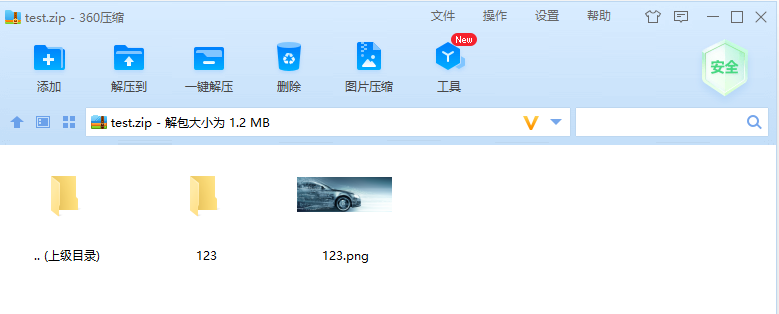本篇文章给大家分享的是有关.Net Core 多文件打包压缩的实现代码怎么写,小编觉得挺实用的,因此分享给大家学习,希望大家阅读完这篇文章后可以有所收获,话不多说,跟着小编一起来看看吧。
最近项目需要实现多文件打包的功能,尝试了一些方法,最后发现使用 ICSharpCode.SharpZipLib 最符合项目的要求。
具体实现如下:

①压缩文件夹
/// <summary>
/// 压缩文件
/// </summary>
/// <param name="fileName">压缩后获得的文件名</param>
public static bool CompressFile(string dir, out string fileName)
{
string dest = System.Environment.GetFolderPath(System.Environment.SpecialFolder.Desktop) + "\\" + string.Format("{0:yyyyMMddHHmmss}", DateTime.Now) + ".zip"; //默认压缩在桌面上
if (!Directory.Exists(Path.GetDirectoryName(dest))) //文件不存在就根据路径创建 E:\\test
Directory.CreateDirectory(Path.GetDirectoryName(dest));
using (ZipOutputStream zipStream = new ZipOutputStream(File.Create(dest)))
{
zipStream.SetLevel(6); //压缩级别0-9
CreateZip(dir, zipStream);
fileName = dest;
zipStream.Finish();
zipStream.Close();
}
return true;
}
/// <summary>
/// 压缩内容到 zipStream 流中
/// </summary>
/// <param name="source">源文件</param>
/// <param name="zipStream">目标文件流(全路径+文件名+.zip)</param>
private static void CreateZip(string source, ZipOutputStream zipStream)
{
Crc32 crc = new Crc32();
string[] files = Directory.GetFileSystemEntries(source); //获得所有文件名称和目录名称
foreach (var file in files)
{
if (Directory.Exists(file)) //如果是文件夹里有文件则递归
{
CreateZip(file, zipStream);
}
else //如果不是则压缩
{
using (FileStream fs = File.OpenRead(file))
{
byte[] buffer = new byte[fs.Length];
fs.Read(buffer, 0, buffer.Length);
string tempFileName = file.Substring(file.LastIndexOf("\\") + 1); //获得当前文件路径的文件名
ZipEntry entry = new ZipEntry(tempFileName);
entry.DateTime = DateTime.Now;
entry.Size = fs.Length;
fs.Close();
crc.Reset();
crc.Update(buffer);
entry.Crc = crc.Value;
zipStream.PutNextEntry(entry);
zipStream.Write(buffer, 0, buffer.Length);
}
}
}
}②将指定文件打包压缩 (可打包线上文件)
/// <summary>
/// 打包线上线下文件
/// </summary>
/// <param name="fileList">文件列表</param>
/// <param name="savepath">保存路径</param>
public static void ZipOnlineFile3(List<string> fileList, string savepath)
{
//判断保存的文件目录是否存在
if (!File.Exists(savepath))
{
var file = new FileInfo(savepath);
if (!file.Directory.Exists)
{
file.Directory.Create();
}
}
Crc32 crc = new Crc32();
using (ZipOutputStream zipStream = new ZipOutputStream(File.Create(savepath)))
{
zipStream.SetLevel(9); //压缩级别0-9
foreach (var url in fileList)
{
byte[] buffer = new WebClient().DownloadData(url);
string tempFileName = GetFileNameByUrl(url); //获得当前文件路径的文件名
ZipEntry entry = new ZipEntry(tempFileName);
entry.DateTime = DateTime.Now;
entry.Size = buffer.Length;
crc.Reset();
crc.Update(buffer);
zipStream.PutNextEntry(entry);
zipStream.Write(buffer, 0, buffer.Length);
}
}
}从文件路径读取文件名的方法:
public static string GetFileNameByUrl(string url)
{
//判断路径是否为空
if (string.IsNullOrWhiteSpace(url)) return null;
//判断是否为线上文件
if (url.ToLower().StartsWith("http"))
{
return url.Substring(url.LastIndexOf("/") + 1);
}
else
{
return url.Substring(url.LastIndexOf("\\") + 1);
}
}通过此方法生成的压缩包,所有文件都会显示在同一层。
③如果需要在文件中创建目录,需要在文件名称上指定文件路径
添加工具类:
/// <summary>
/// 文件对象
/// </summary>
public class FileItem
{
/// <summary>
/// 文件名称
/// </summary>
public string FileName { get; set; }
/// <summary>
/// 文件路径
/// </summary>
public string FileUrl { get; set; }
}
压缩文件的方法:
/// <summary>
/// 打包线上线下文件
/// </summary>
/// <param name="zipName">压缩文件名称</param>
/// <param name="fileList">文件列表</param>
/// <param name="savepath">保存路径</param>
public static string ZipFiles(string zipName, List<FileItem> fileList, out string error)
{
error = string.Empty;
string path = string.Format("/files/zipFiles/{0}/{1}/{2}/", DateTime.Now.Year, DateTime.Now.Month, DateTime.Now.Day);
//文件保存目录
string directory = FileSavePath + path;
string url = FileHostUrl.TrimEnd('/') + path + zipName;
string savePath = directory + zipName;
try
{
if (!Directory.Exists(directory))
{
Directory.CreateDirectory(directory);
}
using (ZipOutputStream zipStream = new ZipOutputStream(File.Create(savePath)))
{
zipStream.SetLevel(9); //压缩级别0-9
foreach (var item in fileList)
{
byte[] buffer = new WebClient().DownloadData(item.FileUrl);
ZipEntry entry = new ZipEntry(item.FileName);
entry.DateTime = DateTime.Now;
entry.Size = buffer.Length;
zipStream.PutNextEntry(entry);
zipStream.Write(buffer, 0, buffer.Length);
}
}
}
catch (Exception ex)
{
error = "文件打包失败:" + ex.Message;
}
return url;
}调用参数示例:
{
"zipName": "test.zip",
"fileList": [
{
"fileName": "123.png",
"fileUrl": "https://file.yidongcha.cn/files/uploadfiles/image/2021/11/15/11c6de395fcc484faf4745ade62cf6e6.png"
},
{
"fileName": "123/456/789.jpg",
"fileUrl": "https://file.yidongcha.cn/files/uploadfiles/image/2021/11/15/fe922b250acf4344b8ca4d2aad6e0355.jpg"
}
]
}生成的结果:

以上就是.Net Core 多文件打包压缩的实现代码怎么写,小编相信有部分知识点可能是我们日常工作会见到或用到的。希望你能通过这篇文章学到更多知识。更多详情敬请关注亿速云行业资讯频道。
免责声明:本站发布的内容(图片、视频和文字)以原创、转载和分享为主,文章观点不代表本网站立场,如果涉及侵权请联系站长邮箱:is@yisu.com进行举报,并提供相关证据,一经查实,将立刻删除涉嫌侵权内容。